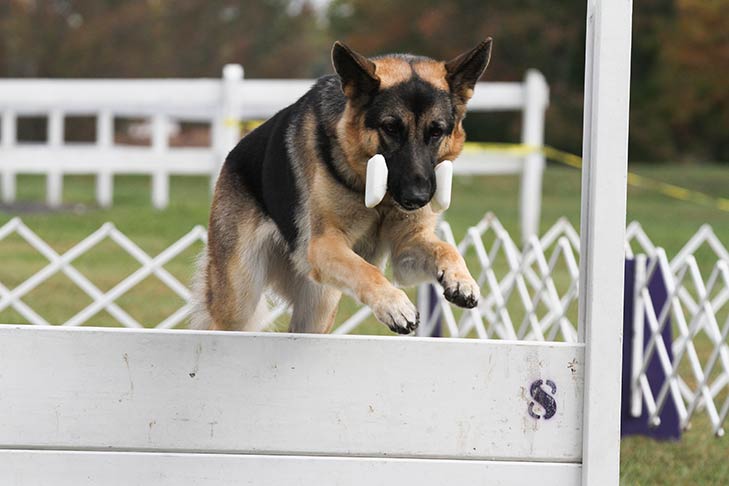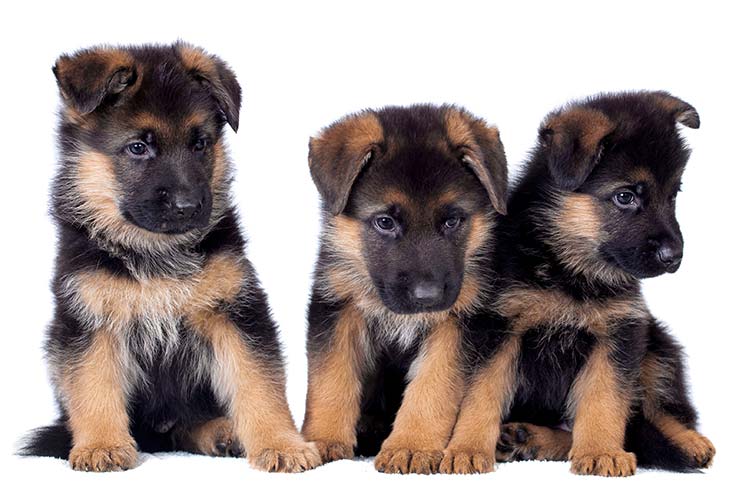ALL THE BREEDERS, AT LAKESIDE SHEPHERDS, ARE REGISTERED WITH THE AMERICAN KENNEL CLUB.
The information below is from the American Kennel Club (AKC) website.
German Shepherd Dog
The German Shepherd Dog was recognized as a breed by the AKC in 1908.

AKC Breed Colors
| DESCRIPTION | STANDARD COLOR | REGISTRATION CODE |
| Black | 007 | |
| Black & Cream | 010 | |
| Black & Red | 014 | |
| Black & Silver | 016 | |
| Black & Tan | 018 | |
| Gray | 100 | |
| Sable | 164 | |
| White | 199 | |
| Liver | 123 | |
| Blue | 037 | |
| Bi-Color | 454 |
About the Breed
Generally considered dogkind’s finest all-purpose worker, the German Shepherd Dog is a large, agile, muscular dog of noble character and high intelligence. Loyal, confident, courageous, and steady, the German Shepherd is truly a dog lover’s delight. German Shepherd Dogs can stand as high as 26 inches at the shoulder and, when viewed in outline, presents a picture of smooth, graceful curves rather than angles. The natural gait is a free-and-easy trot, but they can turn it up a notch or two and reach great speeds. There are many reasons why German Shepherds stand in the front rank of canine royalty, but experts say their defining attribute is character: loyalty, courage, confidence, the ability to learn commands for many tasks, and the willingness to put their life on the line in defense of loved ones. German Shepherds will be gentle family pets and steadfast guardians, but, the breed standard says, there’s a ‘certain aloofness that does not lend itself to immediate and indiscriminate friendships.‘
What To Expect When Caring For a German Shepherd Dog
Owning a dog is not just a privilege; it’s a responsibility. They depend on us for, at minimum, food and shelter, and deserve much more. When you take a dog into your life, you need to understand the commitment that dog ownership entails.
Grooming
The German Shepherd Dog has a medium-length, double coat consisting of a dense, harsh, and close-lying outer coat with a softer undercoat. The breed is easy to maintain, usually requiring just a quick brushing every few days or so to help remove loose hairs, but they do shed more profusely once or twice a year. During these periods, more frequent brushing will help control the amount of hair that ends up around the house and on the furniture. The German Shepherd only needs an occasional bath. It is important to trim or grind his nails every month if they are not worn down naturally, as overly long nails can cause pain and structural issues.
Exercise
As a very active and athletic breed, the German Shepherd requires lots of exercise for his physical and mental well-being. A dog who is not exercised enough will become frustrated and likely to develop undesirable behaviors. With a puppy, you can start with short daily walks, as well as play sessions in a safely fenced area. Remember to not let the dog off leash, as even the best-trained dog can become distracted and not follow every command. Participating in canine activities such as agility, herding, tracking, and dock diving provides excellent physical and mental exercise and is fun and rewarding for both dog and owner.
Training
Early socialization and puppy training classes are vital, and continuing obedience training will help ensure that the pup will grow to be an adaptable and well-mannered adult. The German Shepherd is a highly intelligent companion and an extraordinary worker. Consistency and positive, reward-based training will yield excellent results. He is extremely bonded to his people, so he is happiest when he lives with his family. He should be raised in the household and exposed to the family’s activities. The German Shepherd Dog Club of America provides detailed training advice for owners on the club’s website.
Nutrition
A high-quality dog food appropriate for the dog’s age (puppy, adult, or senior) will have all the nutrients the breed needs. Table scraps can cause digestive upset, so only give them sparingly, if at all, especially avoiding cooked bones and foods with high fat content. Small pieces of biscuit or the dog’s kibble can be used as treats for training. If you are feeding a high-quality food, vitamin and mineral supplements should not be necessary, although adding small quantities of yogurt, cooked vegetables, or eggs to the food can be beneficial. Learn about which human foods are safe for dogs, and which are not. Check with your vet if you have any concerns about your dog’s weight or diet.

Average sizes and life expectancy of the breed.
HEIGHT
24-26 inches (male)
22-24 inches (female)
WEIGHT
65-90 pounds (male)
50-70 pounds (female)
LIFE EXPECTANCY
7-10 years
German Shepherd Dog Puppies

History

The German Shepherd Dog (Deutshe Schäferhund) descends from the family of German herding dogs that, until the late 19th century, varied in type from district to district.
In the waning years of the 1800s, a German cavalry officer, Captain Max von Stephanitz, made it his mission to develop the ideal German herder. Von Stephanitz and like-minded breeders crossed various strains from the northern and central districts of Germany, resulting in the ancestors of today’s German Shepherd Dog (GSD).
Von Stephanitz co-founded the world’s first club devoted to GSDs and spent 35 years promoting and refining the breed. Today, the GSD’s versatility is so thoroughly deployed in the performance of myriad tasks that it is easy to forget that the breed was originally created to herd sheep. The GSD’s now-famous qualities—intelligence, agility, speed, stealth, and the overall air of firm authority—were forged not in the police academy but in the sheep pasture.
GSDs became popular in the United States in the early 1900s, thanks in part to the adventures of canine movie stars Rin-Tin-Tin and Strongheart. The GSD is among those German breeds, the Dachshund is another, that suffered from anti-German sentiment during and after the world wars. In World War I–era Britain, the breed was referred to as the Alsatian, a name many British dog lovers still prefer.
With the rise of modern livestock management and the decline of herding as a canine occupation, von Stephanitz shrewdly promoted his breed as an ideal K-9 worker. The GSD is today the preferred dog for police and military units the world over.











